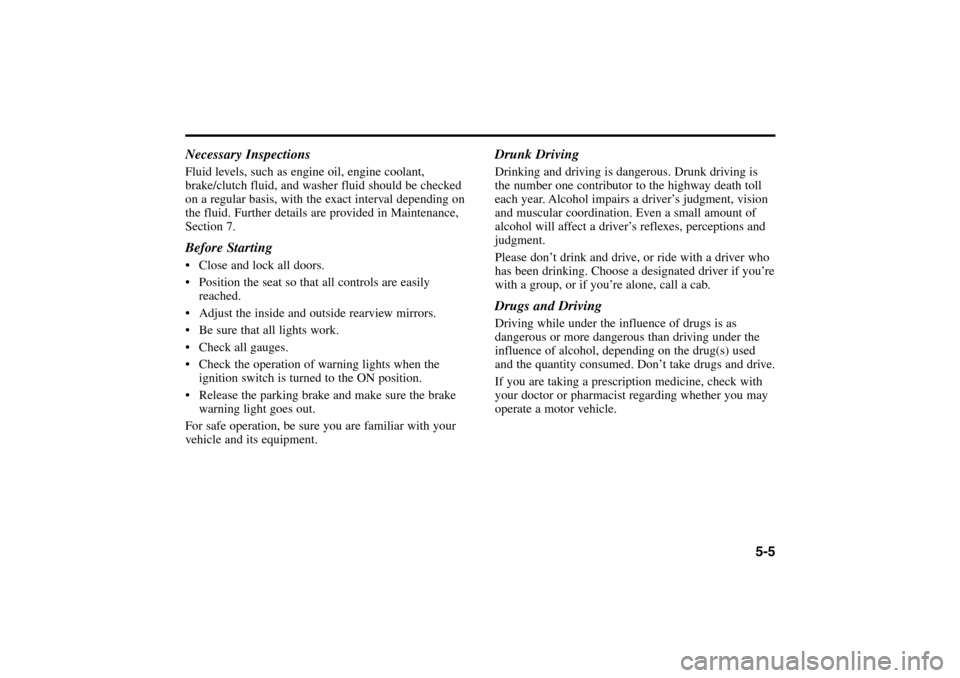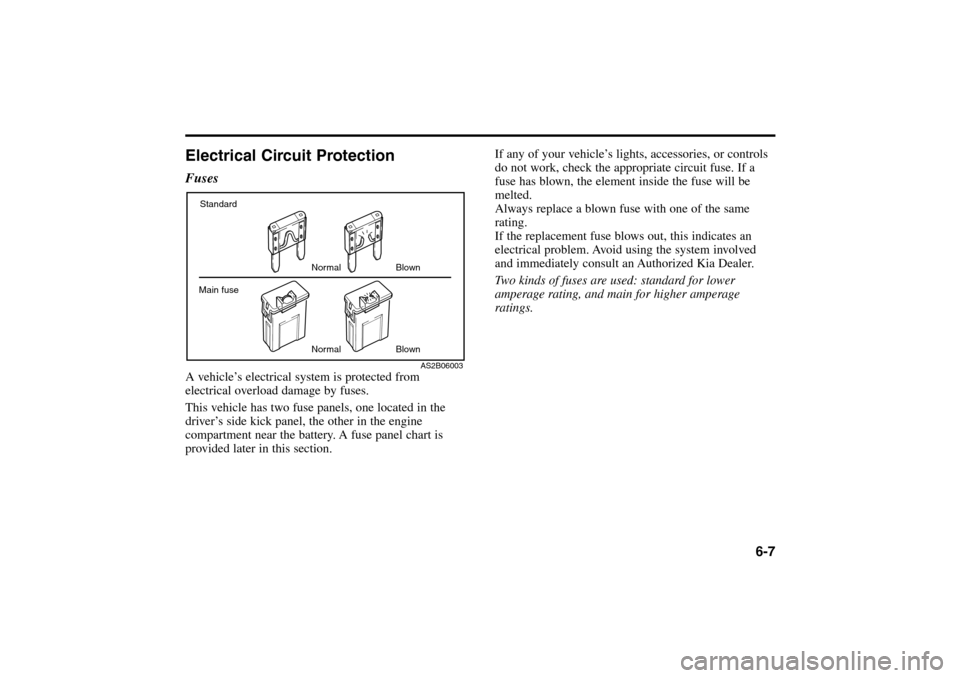check engine light KIA Rio 2005 2.G User Guide
[x] Cancel search | Manufacturer: KIA, Model Year: 2005, Model line: Rio, Model: KIA Rio 2005 2.GPages: 238, PDF Size: 2.6 MB
Page 138 of 238

Operating Precautions for Catalytic ConvertersYour vehicle is equipped with a catalytic converter
emission control device.
Therefore, the following precautions must be observed:
Use only UNLEADED FUEL.
Do not park the vehicle over or near flammable
objects, such as dry grass, paper, leaves, etc. Under
certain conditions, they could be ignited by a hot
exhaust system.
Do not operate the vehicle when there are signs of
engine malfunction, such as misfire or a noticeable
loss of performance.
Do not misuse or abuse the engine. Examples of
misuse are coasting with the ignition off and
descending steep grades in gear with the ignition
off.
Do not operate the engine at high idle speed for
extended periods (5 minutes or more). Do not modify or tamper with any part of the engine
or emission control system. All inspections and
adjustments must be made by a qualified technician.
Failure to observe the above precautions could result in
damage to the catalytic converter and to your vehicle
and could void your warranties.
Before DrivingBefore entering vehicle:
Be sure that all windows, outside mirror(s), and
outside lights are clean.
Check the condition of the tires.
Check under the vehicle for any sign of leaks.
Be sure there are no obstacles behind you if you
intend to back up.
Driving Tips5-4
RIO ENG CNA 5.qxd 7/29/05 5:07 PM Page 4
Page 139 of 238

Necessary InspectionsFluid levels, such as engine oil, engine coolant,
brake/clutch fluid, and washer fluid should be checked
on a regular basis, with the exact interval depending on
the fluid. Further details are provided in Maintenance,
Section 7.Before Starting Close and lock all doors.
Position the seat so that all controls are easily
reached.
Adjust the inside and outside rearview mirrors.
Be sure that all lights work.
Check all gauges.
Check the operation of warning lights when the
ignition switch is turned to the ON position.
Release the parking brake and make sure the brake
warning light goes out.
For safe operation, be sure you are familiar with your
vehicle and its equipment.
Drunk DrivingDrinking and driving is dangerous. Drunk driving is
the number one contributor to the highway death toll
each year. Alcohol impairs a driver’s judgment, vision
and muscular coordination. Even a small amount of
alcohol will affect a driver’s reflexes, perceptions and
judgment.
Please don’t drink and drive, or ride with a driver who
has been drinking. Choose a designated driver if you’re
with a group, or if you’re alone, call a cab.Drugs and DrivingDriving while under the influence of drugs is as
dangerous or more dangerous than driving under the
influence of alcohol, depending on the drug(s) used
and the quantity consumed. Don’t take drugs and drive.
If you are taking a prescription medicine, check with
your doctor or pharmacist regarding whether you may
operate a motor vehicle.
5-5
RIO ENG CNA 5.qxd 7/29/05 5:07 PM Page 5
Page 155 of 238

4. Turn off all unnecessary electrical loads.
5. Connect the jumper cables in the exact sequence
shown in the illustration on the previous page.
First, connect one end of a jumper cable to the
positive terminal (+) of the discharged battery ,
then the other end of the same cable to the positive
terminal (+) on the booster battery . Next,
connect one end of the other jumper cable to the
negative terminal (–) of the booster battery , then
the other end to a solid, stationary, metallic point
(for example, the engine lifting bracket) away
from the battery. Do not connect the jumper cable
to or near any part that moves when the engine is
cranked. Do not connect the jumper cable from the
negative terminal (–) of the booster battery to the
negative terminal (–) of the discharged battery. Do
not allow the jumper cables to contact anything
except the correct battery terminals or the correct
ground. Do not lean over the battery when making
connections.6. Start the engine of the vehicle with the booster
battery and run it at 2,000 rpm. Then, start the
engine of the vehicle with the discharged battery.
If the cause of your battery discharging is not apparent
(for example, having left the lights on accidentally),
you should have your vehicle checked by an Authorized
Kia Dealer.
Push-StartingA vehicle equipped with an automatic transaxle cannot
be started by pushing. A vehicle equipped with a
manual transaxle should not be push-started because it
could damage the emission control system. Follow the
directions for jump starting.
In Case Of An Emergency6-6
CAUTION
Never tow a vehicle to start it. A sudden surge
forward when the engine starts could cause a
collision with the tow vehicle.
1
2
3
4
RIO ENG CNA 6.qxd 7/29/05 5:15 PM Page 6
Page 156 of 238

Electrical Circuit ProtectionFusesA vehicle’s electrical system is protected from
electrical overload damage by fuses.
This vehicle has two fuse panels, one located in the
driver’s side kick panel, the other in the engine
compartment near the battery. A fuse panel chart is
provided later in this section.
If any of your vehicle’s lights, accessories, or controls
do not work, check the appropriate circuit fuse. If a
fuse has blown, the element inside the fuse will be
melted.
Always replace a blown fuse with one of the same
rating.
If the replacement fuse blows out, this indicates an
electrical problem. Avoid using the system involved
and immediately consult an Authorized Kia Dealer.
Two kinds of fuses are used: standard for lower
amperage rating, and main for higher amperage
ratings.
6-7
Standard
Normal
NormalBlown
Blown Main fuse
AS2B06003
RIO ENG CNA 6.qxd 7/29/05 5:15 PM Page 7
Page 158 of 238

If the headlights or other electrical components do not
work and the fuses are OK, check the fuse box in the
engine compartment. If a fuse is blown, it must be
replaced.
1. Turn the ignition switch and all other switches off.
2. Remove the fuse box cover by unhooking the tab on
one end, and tilting the cover back toward the other
end.
3. Check the fuses. If one is blown, replace it with a
new one of the same rating.
6-9
CAUTION
After checking the fuse box in the engine
compartment, make sure the cover is properly
reinstalled. An improperly installed cover could
allow water ingress and lead to electrical failures.
2FDA602
RIO ENG CNA 6.qxd 7/29/05 5:15 PM Page 9